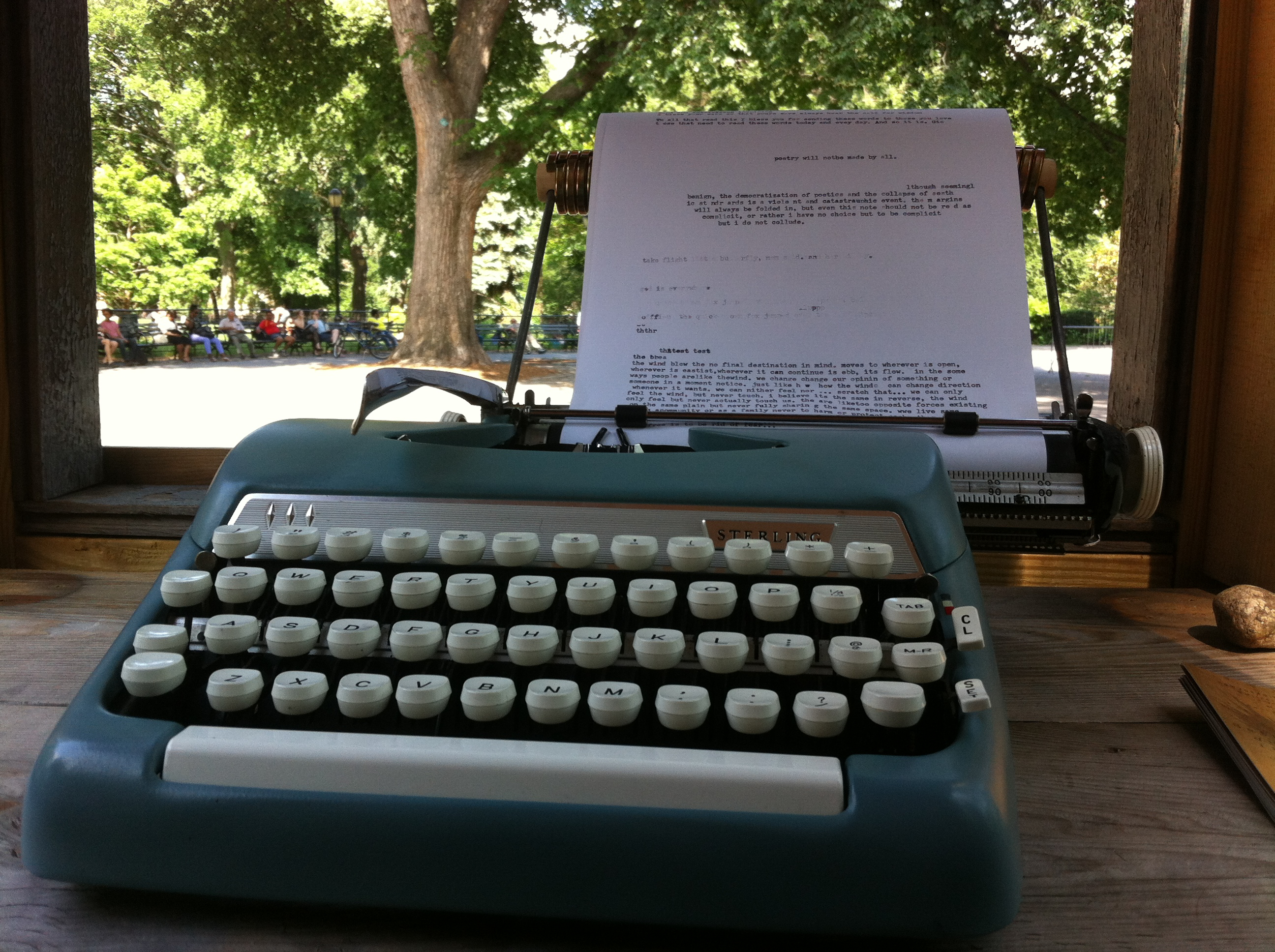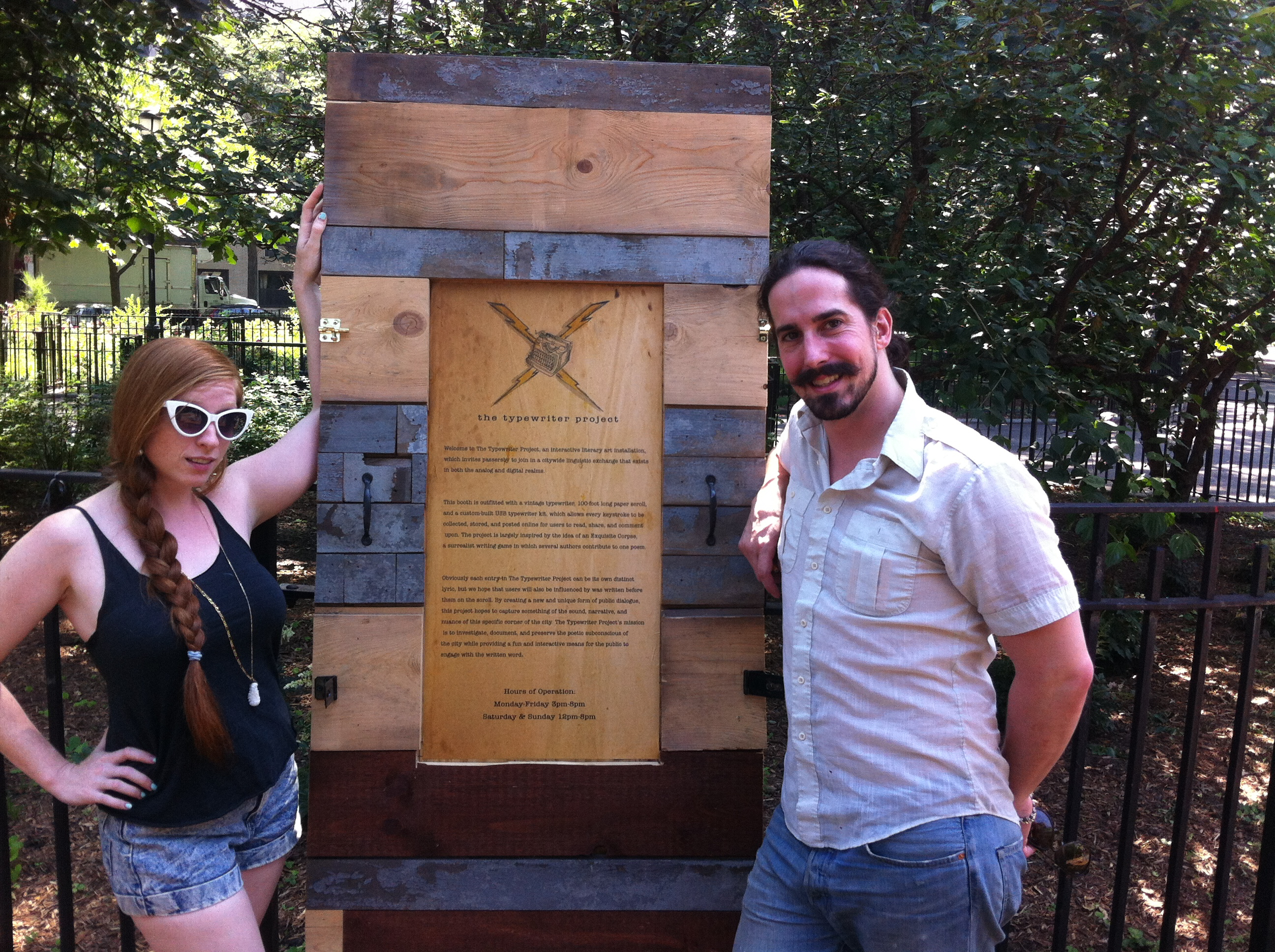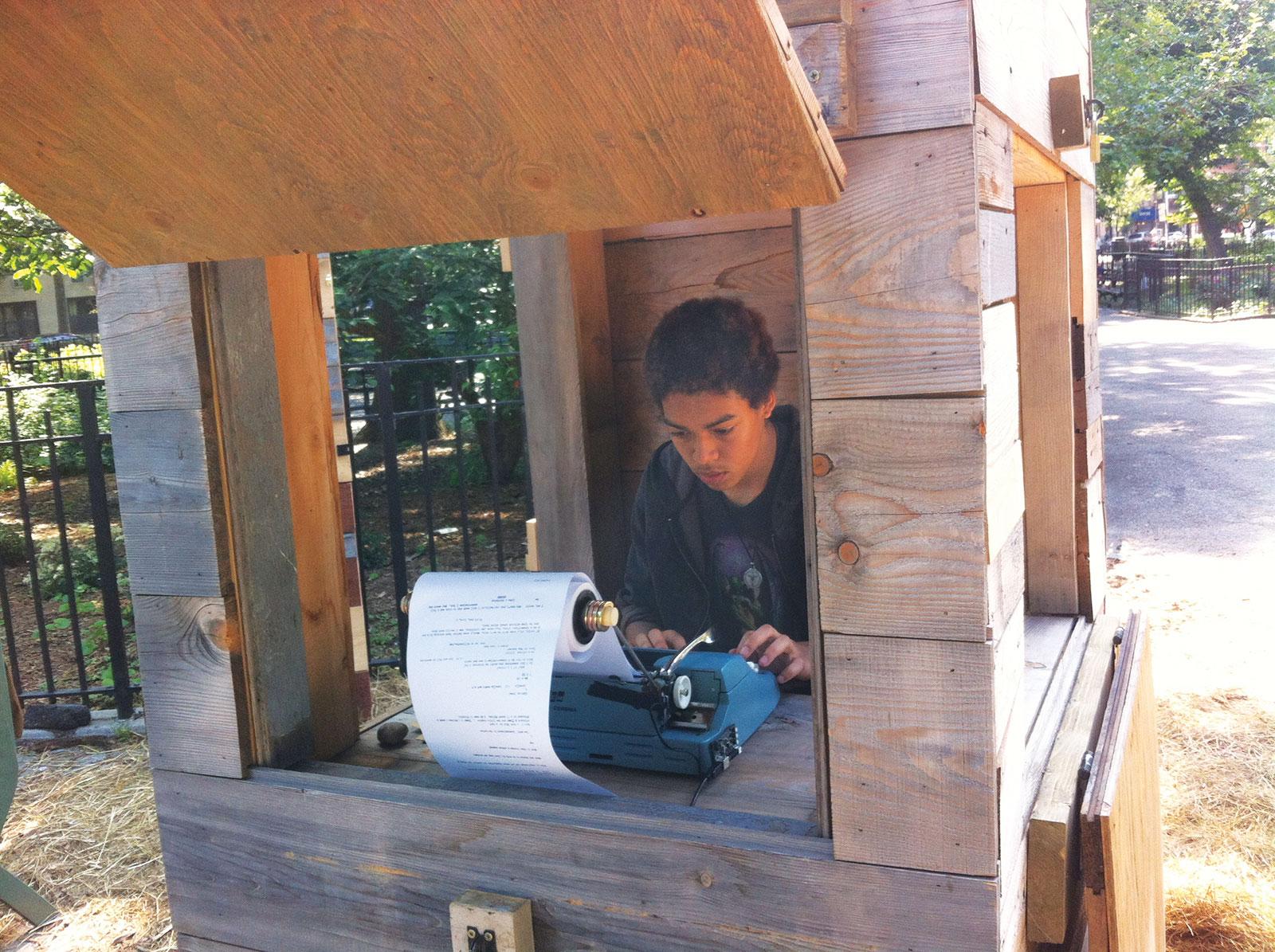
BY SEAN EGAN | Make your way through Tompkins Square Park and you’ll see something new near the Hare Krishna tree — a small, unassuming wooden booth sitting amongst a light layer of straw. Inside this booth is a single, teal-colored typewriter, loaded with a long spool of paper and attached to an iPad (which is hidden out of sight). Passersby are encouraged to step inside the booth, spend some time with their thoughts, and type some poetry onto the scroll — either continuing from the work of the previous writer or taking inspiration from elsewhere. The efforts of these park-visiting poets are then anonymously uploaded to subconsciousofthecity.com.
This is The Typewriter Project (subtitled “The Subconscious of the City”), the brainchild of Stephanie Berger and Nicholas Adamski, who are also the CEO and COO, respectively, of The Poetry Society of New York.
The installation was inspired by the Exquisite Corpse, a form of poetry in which writers take turns writing lines, based on what was written prior to their turn. “One of the things I love doing more than anything else, as a poet and an artist, is collaborating with others — because you’re able to make something more than what you’re able to make on your own,” says Berger, praising the form’s collaborative nature and how, “You can create something totally unexpected and something that you wouldn’t ever make on your own.”
The Typewriter Project is the culmination of a long-percolating, collaborative idea — at least three or four years by the creators’ estimation. Trial and error factored heavily in refining the project — scrolls of paper at an early installation on Governors Island would go missing, and similar events at the fluid retail concept space, Story (144 10th Ave. at 19th St.), helped them learn how different people interacted with the typewriter. They also decided to incorporate the iPad and website because, as Adamski asks, “Why not use all of the technology at our disposal, and maybe push it a bit?”
After all their work, they finally settled on Tompkins Square Park, by the Hare Krishna tree — an area Adamski refers to as a “particularly literary point in Manhattan,” with Berger corroborating, “Allen Ginsberg used to hold writing workshops by that tree.”
It seems the perfect place for the project, as Adamski believes poetry can be “a manifestation of your subconscious or your psyche. This is sort of like: ‘What’s on your mind New York?,’ ” he says. “We built the booth, it has a certain aesthetic we can control. We put a typewriter in it, which is a beautiful old thing — it’s very charming, the sounds it makes, and all that. We pointed out a very beautiful, special tree, and put it in this place, but then, ultimately, when people sit down they’re left alone with their thoughts.” He concludes, “We’re trying to mine that and see, what does someone write if they get ten or fifteen minutes alone in a little booth in a park?”

And what exactly has this shown them? “The typewriter scroll, if you read it, it sounds completely insane,” admits Berger. “It’s like so many different voices. It sounds the way the city sounds more than it sounds like a single person writing a poem.”
Adamski adds, “Even if I would have made something up in my brain about what it might look like or how it might sound or what people might write, there’s no way that I could have been prepared for what’s been written.” He notes with fascination that many of the entries are in Spanish, or gibberish, or clearly written by children.
Their website certainly confirms these claims, revealing the variety of writers who’ve taken a seat at the typewriter. Scouring through entries posted by the anonymous authors yields everything from meditations on love (“the concept of being everything to one person terrifies me.”) to inscrutable comments about the undead (“this is a save point. the zombies cannot eat me this time.”). A string of entries written by various children chronicles an epic-sounding birthday party of one “Nicholas.” One entry reads “I am sitting here with my son and I am not used to typing this anymore. I used to be able to type very fast” — reflecting Adamski’s theory that “[The Typewriter Project]’s kind of bridging a little bit of a generation gap,” and Berger’s that “A lot of humans just don’t know how to type on [typewriters] anymore.”
Standing by The Typewriter Project with the sun shining verifies this, as many people stop to admire the installation. A father explains to his scooter-riding child what exactly a typewriter is. Later on, a group of young girls stare quizzically at the booth, until one takes charge and explains the strange machine, bragging, “My mom used to have one.”
Inside the booth, however, a young man named Darien Nizza-Lazaroff types away diligently for a while, before eventually getting up to leave. He’s a repeat visitor, having attended the initial opening of the Project, and finding the experience enjoyable. “It’s definitely fun and relaxing to use the typewriter. Not many people use or own one in this modern day and age,” he says. “It feels organic.” He leaves, promising staffers that he’ll be back soon to continue writing.

Nizza-Lazaroff seems to embody some of the hopes the founders had for the project. “In some ways, I guess our project is trying to create some kind of literary activism,” Berger laughs. “On an individual level, I hope that people write things that they’re proud of,” Berger says. “On a wider level, I hope that people remember that writing literature is valuable.”
“It’s just the idea that even if poetry doesn’t have the place in the wider culture that it once had, that people might have a moment where they think of themselves as someone who is engaged with it or might want to be engaged with it,” Adamski elaborates.
And if the flurry of activity around The Typewriter Project is any indication, it seems as if it’s doing that job quite well. As one typewriter scribe elegantly puts it: “Found poetry, a lost art.”
The Typewriter Project runs through July 19, at Tompkins Square Park (Ave. A to Ave. B, E. Seventh St. to E. 10th St.), near the Hare Krishna Tree. Hours: Mon.–Fri., 3–8 p.m. and Sat.–Sun., 12–8 p.m. For more info, visit subconsciousofthecity.com. The scrolls produced during this iteration of the project will be on display at The New York City Poetry Festival (newyorkcitypoetryfestival.com) on Governors Island on July 25 & 26 along with the booth itself.

















